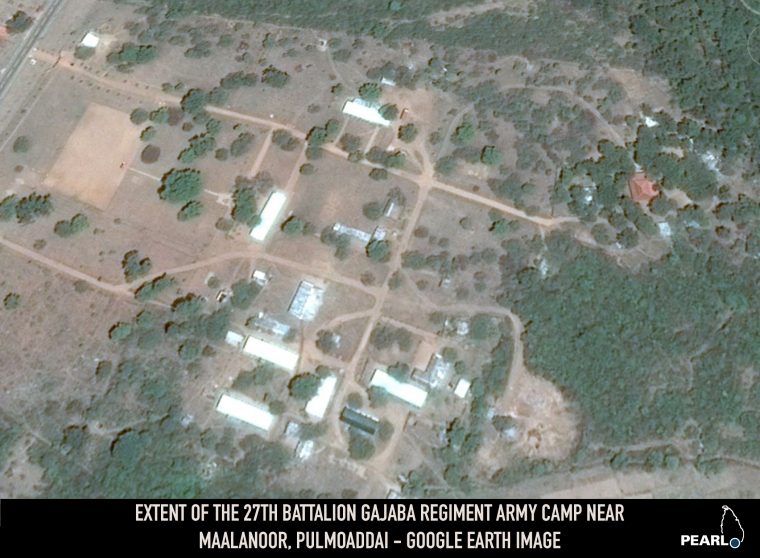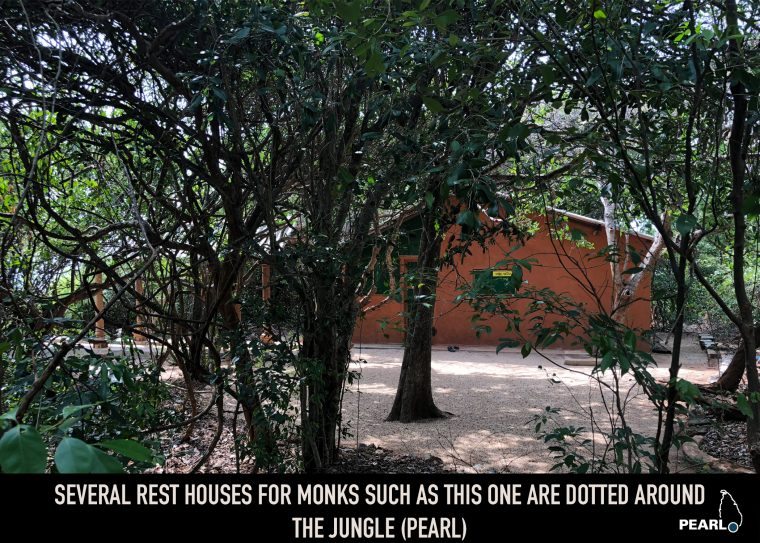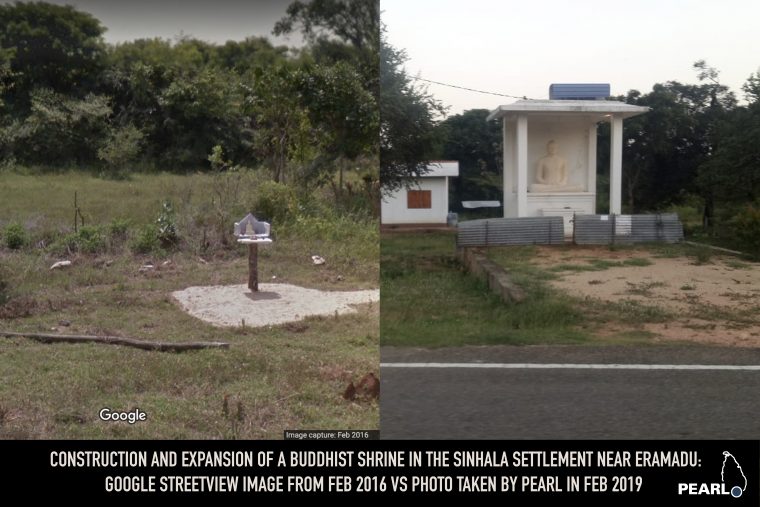by People for Equality and Relief in Lanka (PEARL), September, 2019
The Muslim population in Pulmoaddai has complained of Sinhala colonisation in surrounding areas, particularly since the end of the armed conflict in 2009. The expansion of Sinhala settlements, including along the B60 road and on land owned by Muslims, has alarmed the local population and increased tensions. The proliferation of military camps and Buddhist temples, on top of the settlements, are perceived by locals to be part of a wider effort to Sinhalise the region – dividing the previously contiguous Tamil-speaking populations on the Mullai-Trinco border.
The area is home to the Buddhist monk Thilakawansa Nayaka, a native of Hambantota currently based in Arisimalai, just south of Pulmoaddai town. According to Muslim and Tamil residents, the monk is behind the establishment of the Buddhist temples and Sinhala settlements in the region. He is currently engaged in appropriating land in Pulmoaddai and Thennaimaravaadi for the purpose of constructing Buddhist structures.
A Right to Information request reveals that these settlements were constructed with the consent of the National Housing Development Authority. However the Kuchchaveli Divisional Secretariat confirmed that they did not give permission and that they had given notice to vacate to those who intruded on the land. See full RTI response here. This confirms suspicion by locals that the state acts in contravention of the local authority.
Militarization
The security forces have large camps in the area, including those belonging to the Army, Navy and the Special Task Force. A map of the area shows the encirclement of Pulmoaddai by the Sri Lankan security forces, in all three directions.
To the north, the Navy camp SLNS Ranweli occupies one of the few roads leading to the coast. The camp was built after the end of the armed conflict on land originally owned by civilians. Another small navy outpost is located right on the coast, across Kokkilai town on the other side of the lagoon.
Further east on the B70, closer to the 13th Milepost, the 27 Battalion of the Gajaba Regiment is deployed in a camp.
South of Pulmoaddai, the STF occupies a large camp, while the Gajaba Regiment’s 27th Battalion B Company also has a camp in the area.
On the southeastern boundary of Pulmoaddai town lies Arisimalai, the location of a Buddhist complex, that can only be accessed with permission from the Naval Subdetachment Arisimalai. Another larger Navy camp is located around 200m further down the road.
Buddhisization
Many of the military camps are located close to or even adjacent to Buddhist structures. In at least one case, the Navy camp Ranweli, the Buddhist Vihara has been constructed by navy personnel, on the land opposite their camp. Like the camp, this Vihara is also constructed on private land.
The 27th Battalion of the Gajaba Regiment’s camp is also located a short distance away from the temple constructed near the “Shanthipura” Sinhala settlement. Satellite imagery shows how the Buddhist pansala at “Shanthipura” in 2011 preceded the settlement of Sinhala civilians in the vicinity.
Arisimalai has seen a special focus by Buddhists, due to the presence of ancient ruins. Located in a majority-Muslim and entirely Tamil speaking area, it has seen the construction of a Buddhist temple and adjoining retreat, called Asiri Kanda Purana Rajamaha Viharaya on top of a hillock overlooking the beach. Access to the site is controlled by a Navy camp. The temple was constructed after claims that Buddhist artefacts were found, resulting in the government giving 500 acres for the temple in the early 80s. The aforementioned monk Thilakawanse Nayaka is the chief incumbent of the temple. In 2018 the monk complained about local people encroaching on temple land, and demanded more protection for the area. An official from the Archaeological Department, responsible for the region, also complained about Hindu temples being built and visited by locals. District Secretary Pushpakumara Nissanka said that the Arisimalai Temple has been requesting 500 more acres to be given to the temple premises, and that they decided to grant 25 acres under the religious lands act, while declaring 500 acres as an Archaeological Forest Reserve.
Several Buddhist shrines are dotted around the area. On a cliff, overlooking Pulmoaddai town and the Indian ocean, foundations have been laid for a large stupa.
Arisimalai is a fishing village, renowned for its beach’s large-grained sand (Arisi – rice in Tamil). PEARL researchers visited the area in December 2018 and January 2019. A sign by the Department of Coastal Conservation at the entrance of the path leading to the hill and the beach, warns visitors to abide by rules for the “ancient, sacred area”, including entering the jungle as it “disturbs monks who are meditating”. The path is only accessible with permission by the navy camp. The navy personnel stationed at the checkpoint prohibited us from taking our car up the path, saying that all vehicles had to be parked near the entrance. However, as we walked, a group of Sinhala pilgrims passed us in their van. Buddhist shrines were dotted along the path, which lead to a clearing on an elevation overlooking the Indian Ocean, where the construction of a stupa commenced recently.
Climbing down from the cliff, we reached Arisi Malai beach. The sand really was like rice. As we walked around, we could see the Buddhist temple in the forest, south-west of the beach. We climbed up towards it, passing a meditation bench overlooking the beach and a monk’s rest house. Here the paths were well-demarcated and clean. Signs in Sinhala and English warned against following some paths, saying they are only open to “venerable monks”. Walking further, we reached the temple. The Sinhala pilgrims we saw earlier were giving offerings to a monk, giving us uneasy looks. We hurried past them. As we walked back, we saw the Sinhala van parked right next to the temple.
SINHALA SETTLEMENTS
The demographics of the wider region have seen a drastic increase in the Sinhala population starting prior even to the outbreak of war, particularly in the Padavi Sri Pura region of Trincomalee and the Manal Aaru (Weli Oya) region of Mullaithivu. Pulmoaddai, which occupies the North of the Trincomalee district, has seen more recent settlements established in Maalanoor at the 12th mile post and near Eramadu, at the 10th milepost, including on land owned by Muslims. Settlers who spoke to PEARL in Maalanoor in January 2019 said that they came from Galle, in the south of the country. They call the settlement “Shanthipura”. The road on which the two settlements are located is home to Buddhist temples, several statues, and a meditation centre, which also functions as a base for the archaeological department.
Another statue was completed recently near Eramadu. Google streetview images from 2016 show a small shrine and few makeshift houses, while a February 2019 visit to the area found a larger newly built structure on the same site and an expansion of the settlement into proper houses.
Buddhists are also claiming sites in Thennaimaravaadi, northwest of Pulmoaddai, for Buddhist temples. One site is situated on the road linking Trincomalee to Mullaithivu. The location used to be home to a military camp, which was dismantled. However soldiers left behind a bo tree, which is sacred to Buddhists and often grounds for the declaration of a sacred Buddhist site. The monk Thilakawansa has claimed the location for the construction of a Buddhist temple, despite objections by the local population. No construction has commenced on either site so far. Another site is being claimed by the Department of Archaeology on a hilltop in Thennaimaravaadi. The location was home to a Murugan temple, until the villagers were chased out in 1984 by the Sri Lankan Army. On their return, they found the Hindu temple destroyed. The Department of Archaeology declared the area out of bounds, claiming it was a historic site. In 2018 villagers protested against an attempt to construct a Buddhist statue on the hilltop, demanding the return of the land in order to resume worship. No construction of Buddhist structures has commenced on either site so far.
Pulmoaddai is only one of several locations in the North-East in which Tamil-speaking people have expressed concerns about the government’s deliberate efforts to change the demographics of the region. Since the end of the armed conflict in 2009, the government has constructed at least four navy camps, two army camps, and one Special Task Force camp in Pulmoaddai, including on private land. The proliferation of military camps has often gone hand-in-hand with the construction of Buddhist sites. Our research found at least ten Buddhist structures, some directly linked to a military facility, in the area. The presence of the Buddhist monk Thilakawansa in Arisimalai, coupled with his aggressive, expansionist policies that extend beyond Pulmoaddai, have raised more concerns among the local population. The National Housing Development Authority has also constructed Sinhala settlements in two locations over the last ten years. A Right to Information (RTI) response by the Kuchchaveli Divisional Secretariat stated the settlements were built without the local authority’s permission. The National Housing Development Authority built these houses for Sinhala settlers despite the eviction notices served to the settlers by the Divisional Secretariat. Local Muslim farmers who have traditionally cultivated the area are continuing to resist the increasing settlements on their land. The strategically important area linking the Tamil-speaking-majority provinces of the north and east have been targeted for Sinhalization for decades. This has raised tensions in the region beyond Pulmoaddai. Failure to address the concerns of the local population about these changes risks turning the area into a potential flashpoint. A Muslim civil society leader told PEARL in August 2018: “We will not sit by idly while the state attempts to make our land Sinhalese. Today they have taken our farm land; tomorrow they will take our homes. If the government was serious about peace, they would not do this.”





















